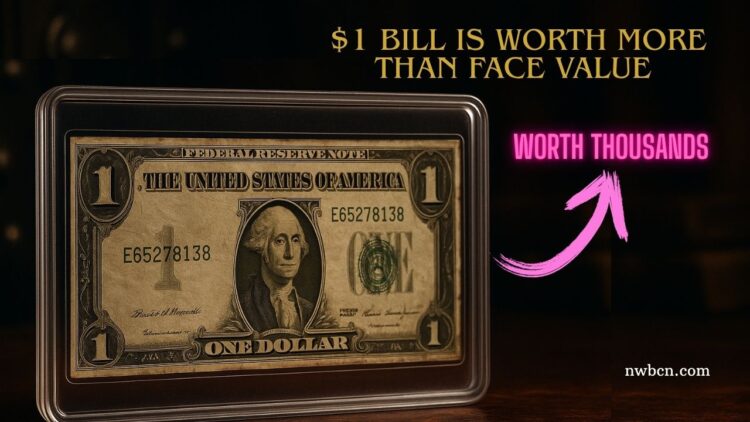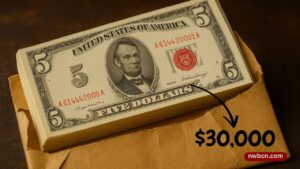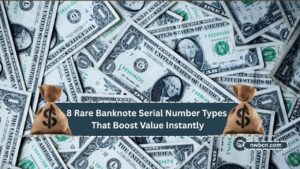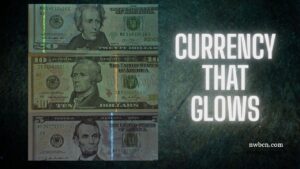Your average $1 bill might be worth more than you think. Among millions in circulation, a few contain rare features that attract collectors and can sell for hundreds or even thousands of dollars.
Whether it’s a printing error or a unique serial number, here’s how to identify if your dollar is worth far more than its face value.
Rare Printing Errors
One of the most valuable signs is a printing error. Some of these slips are so rare that bills with them can fetch thousands of dollars.
- Duplicate Serial Numbers – The Bureau of Engraving and Printing accidentally printed over 6.4 million $1 bills with identical serial numbers across two printings in 2014 and 2016. If you can find a matching pair, collectors have paid as much as $6,000.
- Black Serial Numbers – A printing mishap caused the serial numbers on some 2017 bills to be printed in black instead of the usual green. Some of these have sold for $80 to $2,000, depending on condition and visibility of the error.
Star Notes (★ Replacement Series)
Star notes are printed to replace defective bills removed during production. They are marked by a star symbol next to the serial number.
- A rare star note with a unique printing error or from a scarce series can be incredibly valuable.
- One such example reportedly sold for up to $29,900 due to its scarcity and condition.
- Star notes from certain Federal Reserve Banks, like the 2013 “B” series, are particularly sought after.
Low Serial Numbers
Serial numbers under 00001000 are considered rare. Collectors love bills with:
- 00000001 to 00000999 – These bills, especially when crisp and uncirculated, can fetch hundreds or more.
- The lower the number, the higher the value—especially if the bill is also a star note or from a rare series.
High or Patterned Serial Numbers
Unique or patterned serial numbers are a major attraction to collectors:
- Repeating numbers: Examples include 22222222, 55555555.
- Sequential numbers: Like 12345678 or 00001234.
- Palindromes: Numbers that read the same backward, such as 1234321.
- High serials: Ending in 99999999 are often saved by collectors as the final bills in a series.
Bills with such patterns have sold for hundreds or more, depending on the sequence and condition.
Unusual Series and Federal Reserve Bank Notes
The series year and the Federal Reserve Bank (FRB) identifier can also raise a bill’s value.
- 2013 Series “B” Star Notes from the New York Federal Reserve are especially valuable if they fall within limited print runs.
- 1969B series signed by Joseph Barr are not exceedingly rare but are still collectible in mint condition.
- Some early 20th-century series have unique historical value when preserved in good condition.
Silver Certificates and Historic Notes
While no longer redeemable for silver, silver certificates still carry high collector interest, especially when well-preserved.
- 1928 to 1964 Silver Certificates are frequently collected. A 1935 or 1957 certificate in excellent condition can be worth $10–$30 or more.
- Funnybacks (1928/1934 certificates with distinctive green reverse sides) can sell for hundreds. One example even fetched over $7,500 in pristine condition.
- Educational Series from the late 1800s and early 1900s are highly sought after and can command five-figure sums.
Quick Reference Table: Valuable $1 Bill Signs
| Category | How to Identify | Estimated Value |
|---|---|---|
| Duplicate Serial Error | Matching serial numbers from 2014/2016 printings | Up to $6,000 (for pair) |
| Ink Error | Black serial numbers instead of green | $80 – $2,000+ |
| Star Note | Star (★) near serial number | Up to $30,000+ |
| Low Serial Number | Under 00001000, especially below 00000100 | Hundreds to thousands |
| Patterned Serial | 12345678, 44444444, 10000001, etc. | $100 to several hundred |
| Rare Series/FR Bank | 2013 “B” series, 1969B Barr notes, special FRB letters | $50 – $5,000+ |
| Silver Certificates | Labeled “Silver Certificate,” dated 1928–1964 | $10 – $7,500+ |
How to Spot a Valuable $1 Bill
To determine if your dollar bill is worth more than face value, follow these steps:
- Check the serial number – Look for low numbers, high numbers, patterns, or stars.
- Examine for errors – Misprints, ink smudges, or strange colors can be signs of rarity.
- Look for stars (★) – Usually next to the serial number, indicating a replacement note.
- Note the series and signatures – Older series or rare signatories increase desirability.
- Check the condition – Crisp, uncirculated bills fetch higher prices.
- Avoid folding or damaging potential rare notes – It significantly lowers their value.
Don’t underestimate that ordinary-looking $1 bill in your pocket—it might hold more than just purchasing power. Whether it’s an ultra-rare error, a low or patterned serial number, or a historic silver certificate, certain characteristics can increase its value exponentially.
Collectors are willing to pay top dollar for the right bill in excellent condition. Before spending it, take a closer look—you might be holding a miniature fortune.
Frequently Asked Questions
1. How do I know if my $1 bill is a star note?
Look at the end or beginning of the serial number on your bill. If there is a ★ star symbol, it’s a replacement note. These can be worth more than face value, especially if rare or in pristine condition.
2. Are old $1 bills from the 1960s or earlier valuable?
Yes. Particularly Silver Certificates, Funnybacks, or bills from rare series (like 1935 or 1928) can be quite valuable—especially in uncirculated condition or with errors.
3. Can I sell my rare $1 bill online?
Absolutely. You can sell it through auction sites, collector forums, or even have it appraised and sold via professional currency dealers. Getting the bill graded can also boost its value and buyer trust.




